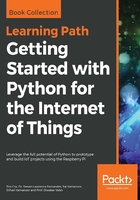
How it works...
The purpose of writing the image file to the SD card in this manner is to ensure that the SD card is formatted with the expected filesystem partitions and files required to correctly boot the operating system.
When Raspberry Pi powers up, it loads some special code contained within the GPU's internal memory (commonly referred to as binary blob by Raspberry Pi Foundation). The binary blob provides the instructions required to read the BOOT partition on the SD card, which (in the case of a NOOBS install) will load NOOBS from the RECOVERY partition. If at this point Shift is pressed, NOOBS will load the recovery and installation menu. Otherwise, NOOBS will begin loading the OS as specified by the preferences stored in the SETTINGS partition.
When loading the operating system, it will boot via the BOOT partition, using the settings defined in config.txt and options in cmdline.txt to finally load to the desktop on the root partition. Refer to the following diagram:

operating systems and to provide recovery
NOOBS allows the user to optionally install multiple operating systems on the same card and provides a boot menu to choose between them (with an option to set a default value in the event of a time-out period).
If you later add, remove, or re-install an operating system, ensure first that you make a copy of any files, including system settings you wish to keep, as NOOBS may overwrite everything on the SD card.